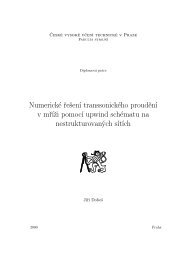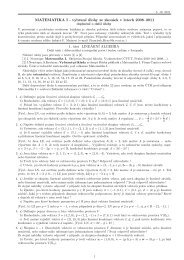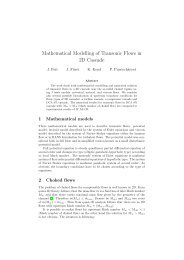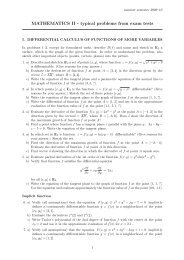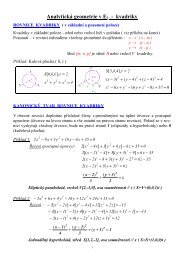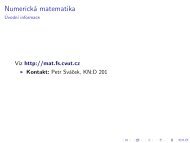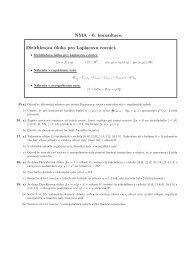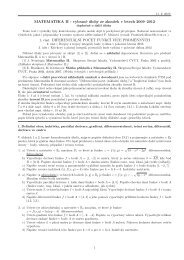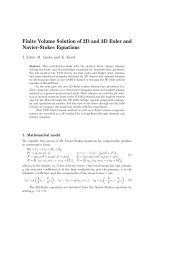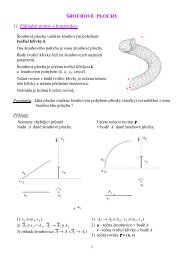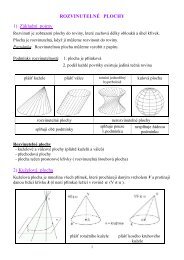The HLLC Riemann Solver
The HLLC Riemann Solver
The HLLC Riemann Solver
You also want an ePaper? Increase the reach of your titles
YUMPU automatically turns print PDFs into web optimized ePapers that Google loves.
<strong>The</strong> <strong>HLLC</strong> <strong>Riemann</strong> <strong>Solver</strong>Eleuterio TOROLaboratory of Applied MathematicsUniversity of Trento, Italytoro@ing.unitn.ithttp://www.ing.unitn.it/toroAugust 26, 2012
Abstract:This lecture is about a method to solve approximatelythe <strong>Riemann</strong> problem for the Euler equationsin order to derive a numerical flux for a conservative method:<strong>The</strong> <strong>HLLC</strong> <strong>Riemann</strong> solverREFERENCES:E F Toro, M Spruce and W Speares.Restoration of the contact surface in the HLL <strong>Riemann</strong> solver. Technical report CoA 9204. Department ofAerospace Science, College of Aeronautics, Cranfield Institute of Technology. UK. June, 1992.E F Toro, M Spruce and W Speares.Restoration of the contact surface in the Harten-Lax-van Leer <strong>Riemann</strong> solver. Shock Waves. Vol. 4, pages 25-34,1994.
Consider the general Initial Boundary Value Problem (IBVP)PDEs : U t + F(U) x = 0 , 0 ≤ x ≤ L , t > 0 ,ICs : U(x, 0) = U (0) (x) ,BCs : U(0, t) = U l (t) , U(L, t) = U r (t) ,with appropriate boundary conditions, as solved by the explicitconservative schemeU n+1i= U n i − ∆t∆x [F i+ 1 2<strong>The</strong> choice of numerical flux F i+12two classes of fluxes:⎫⎬⎭ (1)− F i−1 ] . (2)2determines the scheme. <strong>The</strong>re◮ Upwind or Godunov-type fluxes (wave propagationinformation used explicitly) and◮ Centred or non-upwind (wave propagation information NOTused explicitly).
Godunov’s flux (Godunov 1959) isF i+12= F(U i+1 (0)) , (3)2in which U i+1 (0) is the exact similarity solution U2i+1 (x/t) of the2<strong>Riemann</strong> problem⎫U t + F(U)⎧ x = 0 ,⎪⎬⎨ U L if x < 0 ,(4)U(x, 0) =⎩⎪⎭U R if x > 0 ,evaluated at x/t = 0.
Example: 3D Euler equations.⎡ ⎤ ⎡ρρuU =⎢ ρv⎥⎣ ρw ⎦ , F = ⎢⎣Eρuρu 2 + pρuvρuwu(E + p)⎤⎥⎦ . (5)<strong>The</strong> piece–wise constant initial data, in terms of primitivevariables, is⎡ ⎤ ⎡ ⎤ρ Lρ Ru LW L =⎢ v L⎥⎣ w L⎦ , W u RR =⎢ v R⎥⎣ w R⎦ . (6)p Lp R
<strong>The</strong> Godunov flux F(U i+1 (0)) results from evaluation U2i+1 (x/t)2at x/t = 0, that is along the t–axis.(u-a)p*tu*(u,u,u)(u+a)ρuvwpLLLLLρvwρ*L *RL vRL0Fig. 1. Structure of the exact solution U i+1 (x/t) of the <strong>Riemann</strong>2problem for the x–split three dimensional Euler equations. <strong>The</strong>reare five wave families associated with the eigenvaluesu − a, u (of multiplicity 3) and u + a.wRρuvwpRRRRRx
Integral RelationsConsider the control volume V = [x L , x R ] × [0, T ] depicted in Fig.2, withx L ≤ TS L , x R ≥ TS R , (7)S L and S R are the fastest signal velocities and T is a chosen time.<strong>The</strong> integral form of the conservation laws in (4) in V reads∫ xR∫ xR∫ T∫ TU(x, T )dx = U(x, 0)dx+ F(U(x L , t))dt− F(U(x R , t))dt .x L x L00(8)Evaluation of the right–hand side of this expression gives∫ xRU(x, T )dx = x R U R − x L U L + T (F L − F R ) , (9)x Lwhere F L = F(U L ) and F R = F(U R ).We call (9) the consistency condition.
Now split left–hand side of (8) into three integrals, namely∫ xR∫ TSL∫ TSR∫ xRU(x, T )dx = U(x, T )dx + U(x, T )dx + U(x, T )dxx L x L TS L TS RSLtSRTxLTSLTSRFig. 2. Control volume [x L , x R ] × [0, T ] on x–t plane. S L and S R are thefastest signal velocities arising from the solution of the <strong>Riemann</strong> problem.xRx
Evaluate the first and third terms on the right–hand side to obtain∫ xR∫ TSRU(x, T )dx = U(x, T )dx+(TS L −x L )U L +(x R −TS R )U R .x L TS LComparing (10) with (9) gives(10)∫ TSRTS LU(x, T )dx = T (S R U R − S L U L + F L − F R ) . (11)On division through by the length T (S R − S L ), which is the widthof the wave system of the solution of the <strong>Riemann</strong> problembetween the slowest and fastest signals at time T , we have∫1 TSRU(x, T )dx = S RU R − S L U L + F L − F R. (12)T (S R − S L ) TS LS R − S L
Thus, the integral average of the exact solution of the <strong>Riemann</strong>problem between the slowest and fastest signals at time T is aknown constant, provided that the signal speeds S L and S R areknown; such constant is the right–hand side of (12) and we denoteit byU hll = S RU R − S L U L + F L − F RS R − S L. (13)We now apply the integral form of the conservation laws to the leftportion of Fig. 10.2, that is the control volume [x L , 0] × [0, T ]. Weobtain∫ 0TS LU(x, T )dx = −TS L U L + T (F L − F 0L ) , (14)where F 0L is the flux F(U) along the t–axis. Solving for F 0L wefindF 0L = F L − S L U L − 1 T∫ 0TS LU(x, T )dx . (15)
Evaluation of the integral form of the conservation laws on thecontrol volume [0, x R ] × [0, T ] yieldsF 0R = F R − S R U R + 1 T∫ TSR<strong>The</strong> reader can easily verify that the equalityF 0L = F 0R0U(x, T )dx . (16)results in the consistency condition (9). All relations so far areexact, as we are assuming the exact solution of the <strong>Riemann</strong>problem.
<strong>The</strong> HLL flux F hll for the subsonic case S L ≤ 0 ≤ S R is found byinserting U hll in (13) into (15) or (16) to obtainorF hll = F L + S L (U hll − U L ) , (18)F hll = F R + S R (U hll − U R ) . (19)Use of (13) in (18) or (19) gives the HLL fluxF hll = S RF L − S L F R + S L S R (U R − U L )S R − S L(20)for the subsonic case S L ≤ 0 ≤ S R .
<strong>The</strong> corresponding HLL intercell flux for the approximate Godunovmethod is then given by⎧F L if 0 ≤ S L ,F hlli+ 1 2⎪⎨=⎪⎩S R F L − S L F R + S L S R (U R − U L )S R − S L, if S L ≤ 0 ≤ S R ,F R if 0 ≥ S R .(21)◮ Given the speeds S L and S R we have an approximate intercellflux (21) to be used in the conservative formula (2) toproduce an approximate Godunov method.◮ A shortcoming of the HLL scheme, with its two-wave model,is exposed by contact discontinuities, shear waves andmaterial interfaces, or any type of intermediate waves.
<strong>The</strong> <strong>HLLC</strong> Approximate <strong>Riemann</strong> <strong>Solver</strong> (Toro et al, 1992).◮ <strong>The</strong> <strong>HLLC</strong> scheme is a modification of the HLL schemewhereby the missing contact and shear waves in the Eulerequations are restored.◮ <strong>HLLC</strong> for the Euler equations has a three-wave modeltS L S*S RU * L U*RU L U R0Fig. 4. <strong>HLLC</strong> approximate <strong>Riemann</strong> solver. Solution in the StarRegion consists of two constant states separated from each otherby a middle wave of speed S ∗ .x
Useful Relations. Consider Fig. 2.◮ Evaluation of the integral form of the conservation laws in thecontrol volume reproduces the result of equation (12), even ifvariations of the integrand across the wave of speed S ∗ areallowed.◮ Note that the consistency condition (9) effectively becomesthe condition (12).◮ By splitting the left–hand side of integral (12) into two termswe obtain1T (S R − S L )∫ TSRTS LU(x, T )dx = U ∗L + U ∗R , (22)
where the following integral averages are introducedU ∗L =U ∗R =∫1 TS∗U(x, T )dx ,T (S ∗ − S L ) TS L∫1 TSRU(x, T )dx .T (S R − S ∗ ) TS ∗⎫⎪⎬⎪⎭(23)Use of (23) into (22) and use of (12), make condition (9)( ) ( )S∗ − SL SR − S ∗U ∗L +U ∗R = U hll , (24)S R − S L S R − S L<strong>The</strong> <strong>HLLC</strong> approximate <strong>Riemann</strong> solver is given as follows⎧xU L , ift ⎪⎨≤ S L ,UŨ(x, t) = ∗L , if S L ≤ x t ≤ S ∗ ,U ⎪⎩ ∗R , if S ∗ ≤ x t ≤ S R ,xU R , ift ≥ S R .(25)
Now we seek a corresponding <strong>HLLC</strong> numerical flux of the form⎧F L , if 0 ≤ S L ,⎪⎨F hllc F= ∗L , if S L ≤ 0 ≤ S ∗ ,(26)i+ 1 2 F ⎪⎩ ∗R , if S ∗ ≤ 0 ≤ S R ,F R , if 0 ≥ S R ,with the intermediate fluxes F ∗L and F ∗R still to be determined, seeFig. 4. By integrating over appropriate control volumes we obtainF ∗L = F L + S L (U ∗L − U L ) , (27)F ∗R = F ∗L + S ∗ (U ∗R − U ∗L ) , (28)F ∗R = F R + S R (U ∗R − U R ) . (29)<strong>The</strong>se are three equations for the four unknowns vectors U ∗L , F ∗L ,U ∗R , F ∗R .
We seek the solution for the two unknown intermediate fluxes F ∗Land F ∗R . <strong>The</strong>re are more unknowns than equations and some extraconditions need to be imposed, in order to solve the algebraicproblem. We imposep ∗L = p ∗R = p ∗ ,u ∗L = u ∗R = u ∗ ,v ∗L = v L , v ∗R = v R ,w ∗L = w L , w ∗R = w R .}for pressure and normal velocity (30)}for tangential velocities(31)Conditions (30), (31) are identically satisfied by the exact solution.In addition we imposeS ∗ = u ∗ (32)and thus if an estimate for S ∗ is known, the normal velocitycomponent u ∗ in the Star Region is known.
Now equations (27) and (29) can be re–arranged asS L U ∗L − F ∗L = S L U L − F L , (33)S R U ∗R − F ∗R = S R U R − F R , (34)where the right–hand sides of (33) and (34) are known constantvectors (data). We also note the useful relationF(U) = uU + pD , D = [0, 1, 0, 0, u] T . (35)Assuming S L and S R to be known and performing algebraicmanipulations of the first and second components of equations(33)–(34) one obtainsp ∗L = p L +ρ L (S L −u L )(S ∗ −u L ) , p ∗R = p R +ρ R (S R −u R )(S ∗ −u R ) .(36)
From (30) p ∗L = p ∗R , which from (36) givesS ∗ = p R − p L + ρ L u L (S L − u L ) − ρ R u R (S R − u R )ρ L (S L − u L ) − ρ R (S R − u R ). (37)Manipulation of (33) and (34) and using p ∗L and p ∗R from (36)givesF ∗K = F K + S K (U ∗K − U K ) , (38)for K=L and K=R, with the intermediate states given as⎡1( )S ∗SK − u KU ∗K = ρ K v KS K − S ∗ ⎢[w K]⎣ E Kp K+ (S ∗ − u K ) S ∗ +ρ K ρ K (S K − u K )<strong>The</strong> final choice of the <strong>HLLC</strong> flux is made according to (26).⎤.⎥⎦(39)
Variation 1 of <strong>HLLC</strong>.From equations (33) and (34) we may write the following solutionsfor the state vectors U ∗L and U ∗RU ∗K = S K U K − F K + p ∗K D ∗S L − S ∗, D ∗ = [0, 1, 0, 0, S ∗ ] , (40)with p ∗L and p ∗R as given by (36). Substitution of p ∗K from (36)into (40) followed by use of (27) and (29) gives direct expressionsfor the intermediate fluxes asF ∗K = S ∗(S K U K − F K ) + S K (p K + ρ L (S K − u K )(S ∗ − u K ))D ∗,S K − S ∗(41)with the final choice of the <strong>HLLC</strong> flux made again according to(26).
Variation 2 of <strong>HLLC</strong>.A different <strong>HLLC</strong> flux is obtained by assuming a single meanpressure value in the Star Region, and given by the arithmeticaverage of the pressures in (36), namelyP LR = 1 2 [p L + p R + ρ L (S L − u L )(S ∗ − u L ) + ρ R (S R − u R )(S ∗ − u R )] .<strong>The</strong>n the intermediate state vectors are given by(42)U ∗K = S K U K − F K + P LR D ∗S K − S ∗. (43)Substitution of these into (27) and (29) gives the fluxes F ∗L andF ∗R asF ∗K = S ∗(S K U K − F K ) + S K P LR D ∗S K − S ∗. (44)Again the final choice of <strong>HLLC</strong> flux is made according to (26).
Remarks.◮ <strong>The</strong> original <strong>HLLC</strong> formulation (38)–(39) enforces thecondition p ∗L = p ∗R , which is satisfied by the exact solution.◮ In the alternative <strong>HLLC</strong> formulation (41) we relax suchcondition, being more consistent with the pressureapproximations (36).◮ <strong>The</strong>re is limited practical experience with the alternative<strong>HLLC</strong> formulations (41) and (44).◮ General equation of state. All manipulations, assuming thatwave speed estimates for S L and S R are available, are valid forany equation of state; this only enters when prescribingestimates for S L and S R .
Multidimensional multicomponent flow.Consider the advection of a chemical species of concentrations q lby the normal flow speed u. <strong>The</strong>n we can write the followingadvection equation∂ t q l + u∂ x q l = 0 , for l = 1, . . . , m .Note that these equations are written in non–conservative form.However, by combining these with the continuity equation weobtain a conservative form of these equations, namely(ρq l ) t + (ρuq l ) x = 0 , for l = 1, . . . , m .<strong>The</strong> eigenvalues of the enlarged system are as before, with theexception of λ 2 = u, which now, in three space dimensions, hasmultiplicity m + 3.
<strong>The</strong>se conservation equations can then be added as newcomponents to the conservation equations in (1) or (4), with theenlarged vectors of conserved variables and fluxes given as⎡ ⎤ ⎡ρρuρvρwU =Eρq 1, F =. . .⎢ ρq l ⎥ ⎢⎣ . . . ⎦ ⎣ρq mρuρu 2 + pρuvρuwu(E + p)ρuq 1. . .ρuq l. . .ρuq m⎤. (45)⎥⎦
<strong>The</strong> <strong>HLLC</strong> flux accommodates these new equations in a verynatural way, and nothing special needs to be done. If the <strong>HLLC</strong>flux (38) is used, with F as in (45), then the intermediate statevectors are given by⎡⎤1S ∗v Kw K[]( )SK − u KE Kp KU ∗K = ρ K + (S ∗ − u K ) S ∗ +S K − S ∗ ρ K ρ K (S K − u K )(q 1 ) K. . .⎢(q l ) K⎥⎣. . .⎦(q m ) Kfor K = L and K = R..(46)
Wave Speed Estimates
We need estimates S L , S ∗ and S R . Davis (1988) suggestedS L = u L − a L , S R = u R + a R , (47)S L = min {u L − a L , u R − a R } , S R = max {u L + a L , u R + a R } .(48)Both Davis (1988) and Einfeldt (1988), proposedS L = ũ − ã , S R = ũ + ã , (49)ũ and ã are the Roe–average particle and sound speeds respectivelyũ =√ρL u L + √ [ρ R u R√ρL + √ , ã = (γ − 1)( ˜H − 1 1/2)] 2ũ2 , (50)ρ Rwith the enthalpy H = (E + p)/ρ approximated as˜H =√ρL H L + √ ρ R H R√ρL + √ ρ R. (51)
Einfeldt (1988) proposed the estimatesfor his HLLE solver, whereS L = ū − ¯d , S R = ū + ¯d , (52)¯d 2 =√ρL a 2 L + √ ρ R a 2 R√ρL + √ ρ R+ η 2 (u R − u L ) 2 (53)andη 2 = 1 √ √ρL ρR2 ( √ ρ L + √ ρ R ) 2 . (54)<strong>The</strong>se wave speed estimates are reported to lead to effective androbust Godunov–type schemes.
One-wave model.Consider a one-wave model with single speed S + > 0.◮ Rusanov: By choosing S L = −S + and S R = S + in the HLLflux (20) one obtains a Rusanov flux (1961)F i+1/2 = 1 2 (F L + F R ) − 1 2 S + (U R − U L ) . (55)◮ Lax-Friedrichs: Another possibility is S + = S n max, the wavespeed for imposing the CFL condition, which satisfiesS n max = C cfl∆x∆t, (56)where C cfl is the CFL coefficient. For C cfl = 1, S + = ∆x∆t ,which gives the Lax–Friedrichs numerical fluxF i+1/2 = 1 2 (F L + F R ) − 1 ∆x2 ∆t (U R − U L ) . (57)
Pressure–Based Wave Speed EstimatesToro et al. (1994) suggested to first find an estimate p ∗ for thepressure in the Star Region and then take⎧⎨q K =⎩S L = u L − a L q L , S R = u R + a R q R , (58)[1 + γ + 12γ (p ∗/p K − 1)1 if p ∗ ≤ p K] 1/2if p ∗ > p K .◮ This choice discriminates between shocks and rarefactions.(59)◮ If the K wave is a rarefaction then the speed S K is the speedof the head of the rarefaction, the fastest signal.◮ If the K wave is a shock wave then the speed is anapproximation of the shock speed.
A simple, acoustic type approximation for pressure is (Toro, 1991)p ∗ = max(0, p pvrs ) , p pvrs = 1 2 (p L + p R ) − 1 2 (u R − u L )¯ρā , (60)where¯ρ = 1 2 (ρ L + ρ R ) , ā = 1 2 (a L + a R ) . (61)Another choice is furnished by the Two–Rarefaction <strong>Riemann</strong>solver, namely[aL + a R − γ−12p ∗ = p tr =(u ] 1/zR − u L )a L /pL z + a R/pRz , (62)whereP LR =( ) z pL; z = γ − 1 . (63)p R 2γ
<strong>The</strong> Two–Shock <strong>Riemann</strong> solver givesp ∗ = p ts = g L(p 0 )p L + g R (p 0 )p R − ∆ug L (p 0 ) + g R (p 0 ), (64)whereg K (p) =for K = L and K = R.[AKp + B K] 1/2, p 0 = max(0, p pvrs ) , (65)
Summary of <strong>HLLC</strong> Fluxes◮ Step I: pressure estimate p ∗ .◮ Step II: wave speed estimates:with⎧⎨q K =⎩andS L = u L − a L q L , S R = u R + a R q R , (66)[1 + γ + 12γ (p ∗/p K − 1)1 if p ∗ ≤ p K] 1/2if p ∗ > p K .S ∗ = p R − p L + ρ L u L (S L − u L ) − ρ R u R (S R − u R )ρ L (S L − u L ) − ρ R (S R − u R )(67). (68)◮ Step III: <strong>HLLC</strong> flux. Compute the <strong>HLLC</strong> flux, according to⎧F L if 0 ≤ S L ,⎪⎨F hllc F= ∗L if S L ≤ 0 ≤ S ∗ ,(69)i+ 1 2 F ⎪⎩ ∗R if S ∗ ≤ 0 ≤ S R ,F R if 0 ≥ S R ,
F ∗K = F K + S K (U ∗K − U K ) (70)and⎡( )SK − u KU ∗K = ρ K S K − S ∗ ⎢⎣E Kρ K+ (S ∗ − u K )1S ∗v Kw K[S ∗ +p K]⎤⎥⎦ρ K (S K − u K )(71).
<strong>The</strong>re are two variants of the <strong>HLLC</strong> flux in the third step, as seenbelow.◮ Step III: <strong>HLLC</strong> flux, Variant 1. Compute the numerical fluxesasF ∗K = S ∗(S K U K − F K ) + S K (p K + ρ L (S K − u K )(S ∗ − u K ))D ∗S K − S ∗,D ∗ = [0, 1, 0, 0, S ∗ ] T ,(72)and the final <strong>HLLC</strong> flux chosen according to (69).◮ Step III: <strong>HLLC</strong> flux, Variant 2. Compute the numerical fluxesasF ∗K = S ∗(S K U K − F K ) + S K P LR D ∗, (73)S K − S ∗with D ∗ as in (72) andP LR = 1 2 [p L+p R +ρ L (S L −u L )(S ∗ −u L )+ρ R (S R −u R )(S ∗ −u R )] .<strong>The</strong> final <strong>HLLC</strong> flux is chosen according to (69).(74)⎫⎪⎬⎪⎭
Numerical Results
Test problems:Test ρ L u L p L ρ R u R p R1 1.0 0.75 1.0 0.125 0.0 0.12 1.0 -2.0 0.4 1.0 2.0 0.43 1.0 0.0 1000.0 1.0 0.0 0.014 5.99924 19.5975 460.894 5.99242 -6.19633 46.09505 1.0 -19.59745 1000.0 1.0 -19.59745 0.016 1.4 0.0 1.0 1.0 0.0 1.07 1.4 0.1 1.0 1.0 0.1 1.0Table 1. Data for seven test problems with exact solution
11.6Density0.5Velocity0.800 0.5 1Position00 0.5 1Position13.8Pressure0.5Internal energy00 0.5 1Position1.80 0.5 1PositionGodunov’s method with <strong>HLLC</strong> <strong>Riemann</strong> solver applied to Test 1,with x 0 = 0.3. Numerical (symbol) and exact (line) solutions arecompared at time 0.2.
12Density0.5Velocity000 0.5 1Position-20 0.5 1Position0.5Pressure0.2500 0.5 1PositionInternal energy10.500 0.5 1PositionGodunov’s method with <strong>HLLC</strong> <strong>Riemann</strong> solver applied to Test 2,with x 0 = 0.5. Numerical (symbol) and exact (line) solutions arecompared at time 0.15.
256Density3Velocity12.5000 0.5 1Position0 0.5 1Position10002500Pressure500Internal energy125000 0.5 1Position00 0.5 1PositionGodunov’s method with <strong>HLLC</strong> <strong>Riemann</strong> solver applied to Test 3,with x 0 = 0.5. Numerical (symbol) and exact (line) solutions arecompared at time 0.012.
3020Density15Velocity10000 0.5 1Position-100 0.5 1Position1800300Pressure900Internal energy15000 0.5 1Position00 0.5 1PositionGodunov’s method with <strong>HLLC</strong> <strong>Riemann</strong> solver applied to Test 4,with x 0 = 0.4. Numerical (symbol) and exact (line) solutions arecompared at time 0.035.
560Density3Velocity-2000 0.5 1Position0 0.5 1Position10002500Pressure500Internal energy125000 0.5 1Position00 0.5 1PositionGodunov’s method with <strong>HLLC</strong> <strong>Riemann</strong> solver applied to Test 5,with x 0 = 0.8. Numerical (symbol) and exact (line) solutions arecompared at time 0.012.
560Density3Velocity-2000 0.5 1Position0 0.5 1Position10002500Pressure500Internal energy125000 0.5 1Position00 0.5 1PositionGodunov’s method with HLL <strong>Riemann</strong> solver applied to Test 5,with x 0 = 0.8. Numerical (symbol) and exact (line) solutions arecompared at time 0.012.
HLL density1.41<strong>HLLC</strong> density1.410 0.5 1position0 0.5 1positionHLL density1.41<strong>HLLC</strong> density1.410 0.5 1position0 0.5 1positionGodunov’s method with HLL (left) and <strong>HLLC</strong> (right) <strong>Riemann</strong>solvers applied to Tests 6 and 7. Numerical (symbol) and exact(line) solutions are compared at time 2.0.
Closing Remarks:
◮ We have presented <strong>HLLC</strong> for the Euler equations.◮ For the 2D shallow water equations see Toro E F Shockcapturing methods for free-surface shallow flows. Wiley andSons, 2001.◮ For Turbulent flow applications (implicit version of <strong>HLLC</strong>), seeBatten, Leschziner and Goldberg (1997).◮ For extensions to MHD equations see Gurski (2004), Li(2005), Mignone et al. (2006++).◮ For application to two-phase flow see Tokareva and Toro, JCP(2010).◮ For extensions see Takahiro (2005) and Bouchut (2007),Mignone (2005).



